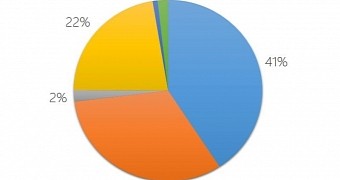The very first testing build of Windows 10 Technical Preview was released to the world on October 1, and since then, no less than 1 million people have downloaded the testing bits, according to Microsoft’s very own statistics.
Now that the very first update was released for download, in the form of Windows 10 Technical Preview build 9860, the company is ready to share more stats, suggesting that this testing program is indeed achieving its purpose.
Microsoft introduced Windows 10 as a revamp of the traditional desktop, bringing back the functionality of Windows 7 mixed with modern elements, such as live tiles and windowed Metro apps.
As a result, the company expects users to install the Technical Preview on their PCs in order to explore the new approach of the Windows operating system, especially when relying on a mouse and keyboard as the main input method. And according to Microsoft, this is indeed happening.
PC users very pleased with Windows 10
A graph posted by Microsoft’s Gabriel Aul on Twitter reveals that 41 percent of those who downloaded and installed Windows 10 Technical Preview did it on their PCs, while 32 percent of the testers tried out the new operating system on laptops.
Only 22 percent of those registered for the Windows insider Program used a virtual machine to test-drive Windows 10 Technical Preview, while just 2 percent deployed the operating system on a tablet.
Microsoft says that the Surface Pro 3 is also being used to see Windows 10 Technical Preview at work, as the tablet was included in the laptop category, but no specifics on how many such tablets are currently registered for the Insider Program have actually been provided.
Designed for the desktop
The new Windows 10 is specifically tweaked to improve the desktop, so many of the improvements that are currently part of the Technical Preview builds are actually enhancing the experience with a mouse and keyboard.
For instance, the new OS includes a Start menu, but also multiple desktops to allow users to better manage their work and running apps.
At the same time, Microsoft is also planning even more improvements in this regard, including a PC version of Cortana that would allow users to perform a number of tasks faster with voice commands. Cortana is currently a Windows Phone-exclusive feature, but the very first testing builds of Windows 10 have already included references of a PC version of the personal assistant, so future versions could also come with a fully-working release.
Here's how #WindowsInsiders are installing 9860 pic.twitter.com/mIXcBSBChT
— Gabriel Aul (@GabeAul) October 24, 2014

 14 DAY TRIAL //
14 DAY TRIAL //